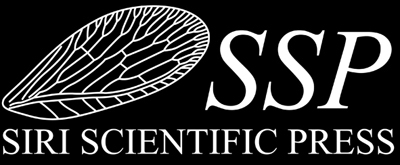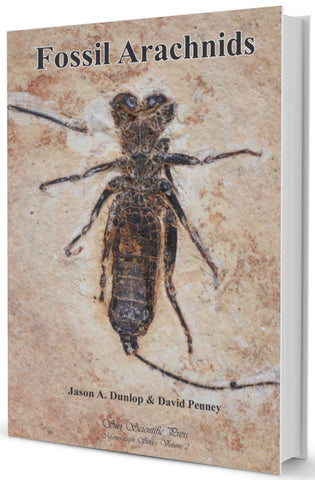FOUR new book reviews on Fossil Insects, Spiders and Arachnids
Posted by David Penney on
We are very pleased to announce FOUR new book reviews on Fossil Insects, Spiders and Other Arachnids in the latest edition of Deposits Magazine. Snippets from the reviews are as follows (click any of the covers to read more reviews, see more info or to order your copy at a discount rate directly from the publisher):
Deposits (2019, issue 57, page 23, edited snippets): “this book is intended to help fill the literature gap by providing an accessible introduction to some of the best preserved fossil insects from a wide range of deposits from around the world. It also covers insect behaviour and ecology (to the extent that they can be extrapolated from the fossil record), sub-fossil insects, trace fossils and the longevity of insect species. And, as with all books published by Siri Scientific Press, it is beautifully illustrated by full colour photographs. It also contains an extensive bibliography for those persons who want to take this fascinating subject further.”
Deposits (2019, issue 57, page 23, snippets): “This book is profusely illustrated with photographs of some of the best examples of fossil spiders, together with diagrams and graphs, and text explanations for each of the specimens displayed. There is no doubt that this book will be interesting to both amateur and professional arachnologists and palaeontologists. However, like many of Siri Scientific Press' publications, it will also be a general palaeontological reference work, including for those studying today's spiders.”
Deposits (2019, issue 57, page 23, snippets): “Fossil Arachnids (spiders, scorpions, harvestmen etc.) are one of the first animal groups to appear on dry land, dating back more than 400 million years to the Silurian period. However, there has been no basic overview of the arachnid fossil record published in an accessible format, suitable for students of biology or geology looking for basic palaeontological information, or for arachnologists interested in what these animals were like millions of years ago. … The book is full of colour photographs, highlighting the appearance and diversity of arachnids, the different ways in which they can become fossilized and the sheer quality of preservation that is sometimes present. Therefore, the book will be of interest both to arachnologists and palaeontologists, and there is little doubt that it will be used as a reference for biologists interested in the evolutionary history of spiders and their many relatives for many years to come.”
Deposits (2019, issue 57, page 22, snippets): “You might think from its subtitle (A comparative palaeontological-neontological approach to identification, faunistics, ecology and biogeography) that its content is rather academic. Well, it is (and this book will undoubtedly be a leading reference work for quite a while) but it is still highly readable and enjoyable. And the text, and 300 or so illustrations and full colour photographs will undoubtedly provide fascinating reading and the potential to identify specimens from Hispaniola. … Perhaps the most fascinating aspect of this book is the way the author combines and compares information derived from both fossil and living spiders, so the reader can relate what they know (for example, from seeing extant spiders) to the remarkably preserved spiders illustrated in this book. In this way, he provides a comprehensive guide to what is known about amber spider fossils from the Dominican Republic.”
Deposits (2019, issue 57, page 23, edited snippets): “this book is intended to help fill the literature gap by providing an accessible introduction to some of the best preserved fossil insects from a wide range of deposits from around the world. It also covers insect behaviour and ecology (to the extent that they can be extrapolated from the fossil record), sub-fossil insects, trace fossils and the longevity of insect species. And, as with all books published by Siri Scientific Press, it is beautifully illustrated by full colour photographs. It also contains an extensive bibliography for those persons who want to take this fascinating subject further.”
Deposits (2019, issue 57, page 23, snippets): “This book is profusely illustrated with photographs of some of the best examples of fossil spiders, together with diagrams and graphs, and text explanations for each of the specimens displayed. There is no doubt that this book will be interesting to both amateur and professional arachnologists and palaeontologists. However, like many of Siri Scientific Press' publications, it will also be a general palaeontological reference work, including for those studying today's spiders.”
Deposits (2019, issue 57, page 23, snippets): “Fossil Arachnids (spiders, scorpions, harvestmen etc.) are one of the first animal groups to appear on dry land, dating back more than 400 million years to the Silurian period. However, there has been no basic overview of the arachnid fossil record published in an accessible format, suitable for students of biology or geology looking for basic palaeontological information, or for arachnologists interested in what these animals were like millions of years ago. … The book is full of colour photographs, highlighting the appearance and diversity of arachnids, the different ways in which they can become fossilized and the sheer quality of preservation that is sometimes present. Therefore, the book will be of interest both to arachnologists and palaeontologists, and there is little doubt that it will be used as a reference for biologists interested in the evolutionary history of spiders and their many relatives for many years to come.”
Deposits (2019, issue 57, page 22, snippets): “You might think from its subtitle (A comparative palaeontological-neontological approach to identification, faunistics, ecology and biogeography) that its content is rather academic. Well, it is (and this book will undoubtedly be a leading reference work for quite a while) but it is still highly readable and enjoyable. And the text, and 300 or so illustrations and full colour photographs will undoubtedly provide fascinating reading and the potential to identify specimens from Hispaniola. … Perhaps the most fascinating aspect of this book is the way the author combines and compares information derived from both fossil and living spiders, so the reader can relate what they know (for example, from seeing extant spiders) to the remarkably preserved spiders illustrated in this book. In this way, he provides a comprehensive guide to what is known about amber spider fossils from the Dominican Republic.”
Share this post
- 0 comment
- Tags: Book review
0 comment




